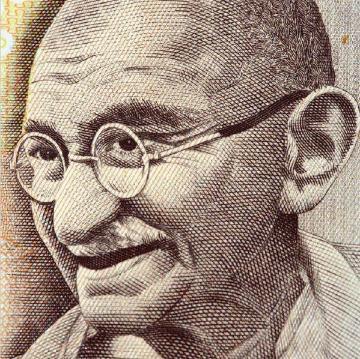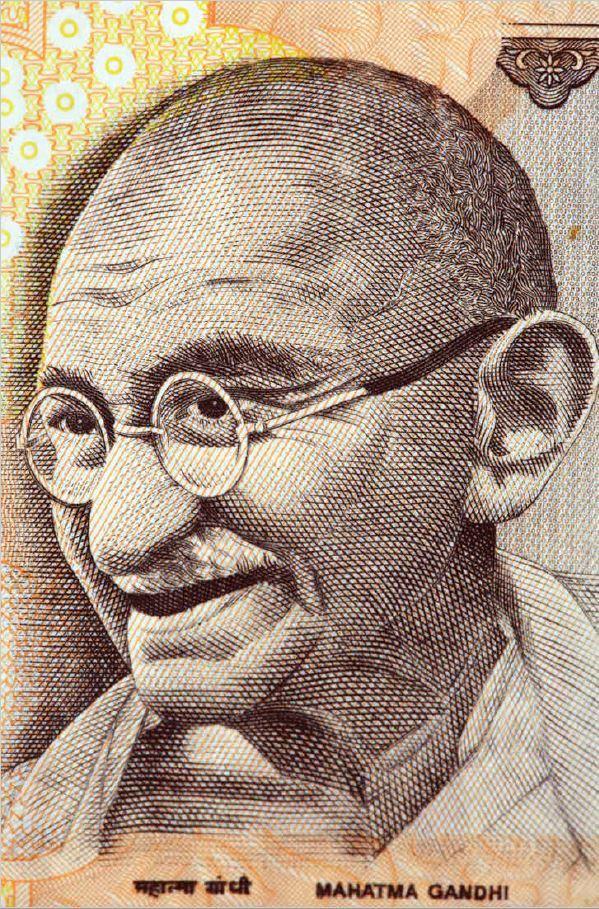
Gandhi, Technology, and the Human Spirit

By Rohit Chopra
Associate Professor, Department of Communication
Santa Clara University
During the 2006–07 academic year as a visiting assistant professor at Emory University—where I’d recently finished my dissertation— I taught an undergraduate course titled From Gandhi to Google: Technology and Nationalism in India from Colonialism to Cyberspace.
The course, which was based on aspects of my dissertation research, examined the many rich meanings of technology in the Indian nationalist and popular imagination in three phases: the period of British colonial rule and anticolonial nationalism that lasted from roughly the mid-18th century until the moment of Indian independence in 1947; the post-independence and postcolonial phase of centralized planning and technological, economic, and industrial development from 1947 to 1991; and the current phase since 1991 during which time India entered the global economy, experienced a boom in software exports, and saw thousands of highly skilled technology workers migrate overseas, especially to technology hubs like Silicon Valley. This most recent phase also roughly coincided with the emergence of a global internet-based economy following the invention of the first “killer app” of the World Wide Web.
As part of the course curriculum, we read a slender book by Gandhi, titled Hind Swaraj or Indian Home Rule. The word swaraj generally means self-rule and can be thought of as a synonym for the independence, autonomy, and freedom that Indians sought from British rule. The term, though, also carries resonances and inflections that resist and escape its translation into the English language. Swaraj, for instance, also refers to the idea of the control of the self, or more literally rule or sovereignty over the self. A key concept in his thought, swaraj for Gandhi represented the idea that Indians would only be able to effectively govern themselves as a sovereign people if they could gain the same sovereignty over their individual selves by mastering their desires, fighting temptations, and quelling their baser instincts. Written in 1909, the book takes the form of a dialogue between two characters, the Editor, who is Gandhi himself, and a character termed the Reader. While short in length, the book contains a plenitude of ideas, whose complexities belie the simplicity with which they are presented. The overarching theme of Hind Swaraj is a critique of Western civilization, which Gandhi treats as synonymous with Western modernity. The critique centers on specific modern Western practices, ideas, and historical achievements, including parliamentary democracy, the political form of the modern nation-state, and industrial technology. The very presence of the British in India and the inequities of colonial rule were justified by the argument that these practices, ideas, and structures represented the superiority of British civilization to its Indian counterpart, a claim accepted by many educated and enlightened Indians, including those involved in the anticolonial nationalist struggle. Gandhi, in Hind Swaraj, set out to dismantle the fundamental premise of British and Western civilizational superiority.
In keeping with Gandhi’s philosophical and polemical goal, one of the key arguments of the book, at face value, appears to be a blanket rejection of Western science and technology, including their most visible symbol in India: the railways. Indian ire toward the railways is easily understood. After all, ever since their introduction during colonial times, the railways have been touted as proof of the benefits of colonial rule to a “backward,” technologically undeveloped society. The claim is easily countered, for instance, in a droll and incisive commentary that recently ran in The Guardian, in which Indian politician and writer Shashi Tharoor notes that the railways were built by the East India Company, the earliest “avatar” of the British colonial state, for their own benefits—also noting that many countries built railways “without having to go to the trouble and expense of being colonised to do so.” But who could disagree with the obvious benefits of Western medicine in fighting disease, especially in a poor country like India, in which large parts of the population have routinely died of preventable diseases, even if that wider condition of misery was itself partly a product of colonial rule?
Indeed, my students in the course were understandably puzzled by these views that Gandhi held. Gandhi’s condemnation of science and technology, including their obvious benefits, stood in stark contrast to the much more readily comprehensible views of India’s first prime minister, Jawaharlal Nehru, on the matter. For Nehru, science and technology represented universal knowledge, regardless of their origins, and were an essential instrument not just for material economic prosperity but for social progress as well. Nehru was well known as an evangelist for what he called the “scientific temper,” a cultivated rational sensibility that stood as the antithesis of the superstition and ignorance that have largely been argued as both cause and consequence of India’s colonial subjugation and humiliation.
The Indian American students in the class were especially dismayed by the gulf in thinking between Gandhi and Nehru on the subject. Like many Indians and those of Indian origin in the U.S., they had been taught by their parents and the wider cultural community to revere Gandhi. Widely seen as the prime architect of Indian freedom through his role in mobilizing a mass nationalist anticolonial movement, Gandhi is affectionately known as “Bapu” and commonly referred to as the “father of the nation” in India. Indian public life, in fact, is marked by the performance of an excessive hagiographic appreciation of Gandhi, with any criticism of Gandhi resulting in public controversy, censure, and proclamations of moral outrage. Gandhi has even been appropriated by some groups of the Hindu right—an irony, as a Hindu nationalist fanatic named Nathuram Godse was responsible for Gandhi’s assassination. The Indian American students in my class, like students in India, had also been taught to revere doctors, scientists, technologists, and engineers and to aspire to work in these professions. Now here they were, situated in this country, justly proud of their Indian heritage and values and on their way to becoming scientists and doctors, while Gandhi was bluntly telling them in our readings that these vocations were perhaps not worth much to humanity and that the values these professions represented were at odds with their Indian identity and heritage.
Any reading of Gandhi as a straightforward statement or generalization, however, is fraught with pitfalls. Gandhi’s scathing critique of Western science and technology is part careful analysis of the impact of technology, part strategic polemic, part clarion call to a moral reflection he demands of Indians. Above all, it is a radical critique of a particular notion of technology that is in contradiction with a holistic idea of the human or the conception of an indivisible human spirit. In this regard, Gandhi’s book is very much in conversation with the theme of this year’s Bannan Forum—that is, the relationship between technology and the human spirit. A close reading of one key passage from Hind Swaraj will shed light on Gandhi’s original and insightful critique of technology.
In a passage that is noteworthy for the jumble of damning accusations that it presents, Gandhi lists numerous specific objections to the railways as an embodiment of Western scientific and technological reason.
“It must be manifest to you that but, for the railways, the English could not have a hold on India as they have. The railways, too, have spread the bubonic plague. Without them, masses could not move from place to place. They are the carriers of plague germs. Formerly we had natural segregation. Railways have also increased the frequency of famines, because, owing to facility of means of locomotion, people sell out their grain and it is sent to the dearest market. People become careless, and the presence of famine increases. They accentuate the evil nature of man. Bad men fulfill their evil designs with greater rapidity. The holy places of India have become unholy. Formerly, people went to these places with great difficulty. Generally, therefore, only the real devotees visited such places. Nowadays, rogues visit them in order to practice their roguery.” (47)
The illogical nature of the claims and the neo-Luddite position in the passage befuddled my students, as I am sure they have many other readers since Gandhi penned the book over a century ago. Gandhi, it should be noted, was no stranger to such statements, nor to holding regressive and controversial views on a number of topics, from sexuality to vegetarianism, natural disasters to race and caste. A case can be made that in his younger years, at least, Gandhi was guilty of racism toward Black people. And, indeed, the statement can be justly interpreted as reductive, simplistic, or regressive. Yet, there is another set of meanings that we can discern in the passage, which has to do with what Gandhi considered the effects of technology on the
essence or spirit of the human. The essence of the human, according to Gandhi, lies in its indivisible and limited nature. “Man is so made by nature,” Gandhi wrote, “as to require him to restrict his movements as far as his hands and feet will take him ... God set a limit to man’s locomotive ambition in the construction of his body. Man immediately proceeded to discover means of overriding the limit” (51). Herein lies the heart of Gandhi’s critique of technology. In enabling a Faustian overreaching in their disruption of the natural order of social interaction or economic life, interwoven with structures of local life, the human life. Gandhi’s deeper concern here was about the capacity of technology to cause violence through enabling humans to transcend the limitations that he saw as essential to ethical life. Scholars like Ashis Nandy and Gyan Prakash suggest that the attrition of humanness that ensues from technology is what undergirds Gandhi’s general objection to technology as well as opposition to specific technologies like the railways.

There are strong and compelling objections that one can raise to Gandhi’s invocation of the existing Indian social order, notably the fact that that order rested on and perpetuated the violent inequities of caste and gender that Hindu reformers have long battled to change. For Dalit leaders like B.R. Ambedkar, who belonged to a so-called “untouchable” caste, the very characteristics of modernity that Gandhi found objectionable—the sense of anonymity it conferred on individuals, its disruption of social relationships, the mobility it afforded “lower-caste” and “untouchable” minority groups to move from villages to cities—were its most valuable aspects, carrying a powerful liberatory and emancipatory power for individual rights against the tyranny and claustrophobic hierarchies of the Hindu community and Indian social structures. In a related vein, Gandhi is also justifiably open to the criticism that he romanticized the notion of community and, like many seminal Indian thinkers and political figures before and after him, saw the community rather than the individual as the unit of Indian social life.
As a broader philosophical argument about technology, though, Gandhi’s critique of the railways in the passage from Hind Swaraj carries much purchase. His arguments also appear more valid if one interprets them as a universal critique of technology beyond the role of technology in only an Indian setting. Gandhi’s objections to the railways are first and foremost that they enable actions that can easily be divorced from their consequences or the immediate structures of social obligation and accountability required by the bonds of social life. Rather than provide for members of their immediate community and neighbors, farmers can use the railways to take grain to distant places for the best price even at the risk of contributing to a famine. The reference here is likely to the many famines that India experienced under British colonial rule, which were caused not just by drought but by British policies and the larger political economy of colonial exploitation. According to Tharoor, the toll from famines totaled a staggering 35 million deaths.
Under the system in place, Indian raw materials were exported to Britain to be manufactured as mass produced goods, which were then sold back to Indians, in the bargain devastating local economies and industries. This line of argument is linked to Gandhi’s related claim in the passage that the railways have enabled a compartmentalization, commodification, and marketization of human life by separating economic imperatives, motives, and objectives from social, ecological, and moral concerns. For Gandhi, it was the very unity of the different dimensions of ecological that defined the human spirit; human existence was meaningless if not predicated on its holistic nature. The separation of different aspects of human existence worked to the advantage of overtly unethical people, while threatening to lure others into unethical action as well. Gandhi’s perspective on technology here presciently anticipates a seminal insight in Martin Heidegger’s essay “The Question Concerning Technology”—that technology has reframed humans as a “standing-reserve.” Heiddeger argues that the standing reserve is not merely a source of power or human capacity but rather part of an extractive rearrangement of the order of nature in which humans become a means to a technological end or system.
Some of these objections, as general insights about technology, apply to the very different technological form of social media that Gandhi and those in his world could not have anticipated. A common and well-founded argument against the negative effects of social media platforms like Twitter and Facebook is precisely that they enable a deeply problematic divorce between action and accountability, in part by enabling the same kind of anonymity and distance that Gandhi found so troubling about the railways. The critique holds for the pervasive online plague of trolling, the epidemic of fake news, and the culture of antagonistic polarization that characterizes much online discourse currently. Likewise, the disruptions that Facebook and Twitter have caused to political and social life through their undermining of democratic processes echo Gandhi’s claim about the deployment of the railways by the British to keep India under the colonial yoke. The claim about rogues exploiting technology recalls the weaponization of Facebook by figures like Steve Bannon in their use of the services provided by the data mining firm, Cambridge Analytica, to skew the results of the 2016 U.S. presidential elections, or the use of WhatsApp by the Hindu right to plan assaults and riots against Muslims in the past few years since the political and public ascendancy of Hindu fundamentalists and extremists.
Gandhi’s solutions to the problems posed by Western technology and, more broadly, by Western modernity do not appear practical or feasible today. For the individual, Gandhi advocated a puritanical moral code of austere existence involving a level of self-denial that would be nearly impossible for most people to follow today, as it arguably was in 1909 as well. For society at large, Gandhi recommended the rejection of the very idea of the modern nation-state and formal, parliamentary democracy. Instead, in Gandhi’s alternate vision of modern Indian society, the structures of the nation-state and democracy would be replaced by a community of communities, each unit from the individual village onward embedded into a larger circle of community all the way through to the nation, a concentric circle of social networks that provided stability, order, and balance. Yet, even with its flaws and very pointed criticism of aspects of British colonial rule, Gandhi’s message about the threats of a certain vision of technology to human life and the human spirit remain relevant today. We see social media platforms like Facebook running roughshod over democracy across the world. We see them hiding behind the fig leaves of free speech and neutrality in defending their refusal to do anything about the hate speech, abuse, and violence to which many of their users resort. We see the abuse of surveillance technologies and data mining in economically exploiting the most painful details and vulnerabilities of people’s lives and categorizing minorities on the basis of racial stereotypes.
We do not need to throw the proverbial baby out with the bathwater and seek to shut down these technological forms and advances. Yet, in understanding how to limit their abuse or in seeking to start conversations about the role of such technologies and technology in general in our lives, we would be well served to listen to Gandhi on technology and the human spirit.
ROHIT CHOPRA, Ph.D., is associate professor in the Department of Communication at Santa Clara University. His research focuses on the relationship between global media and identity, the social and cultural impact of new media technologies, and media and memory. He is the author, most recently, of The Virtual Hindu Rashtra: Saffron Nationalism and New Media (HarperCollins: New Delhi, 2019). His current research projects center on media memories of religious violence in Mumbai, India, in the early 90s, and disability in global media and culture.